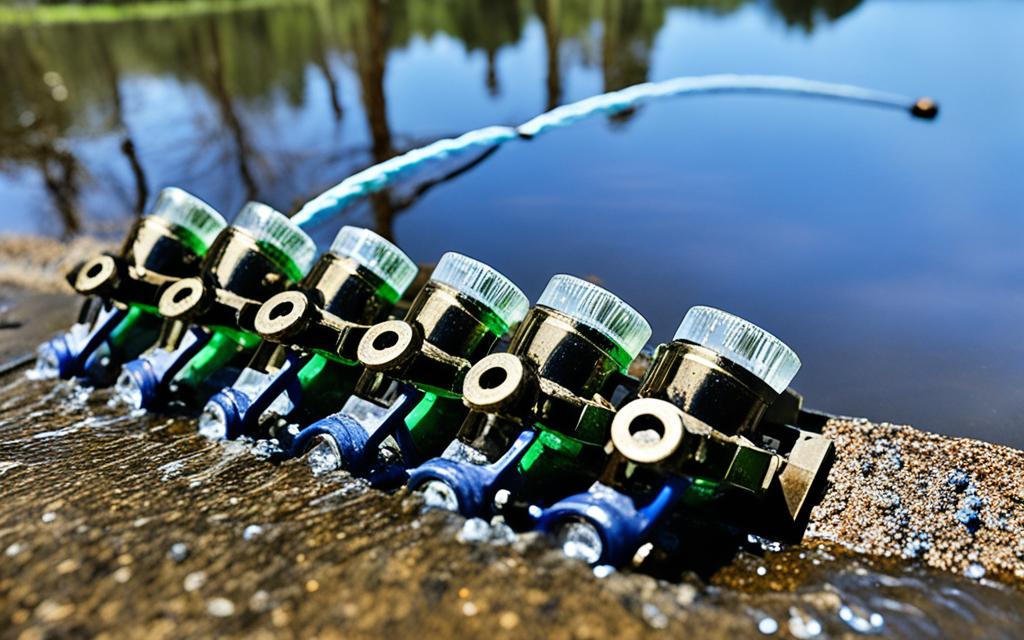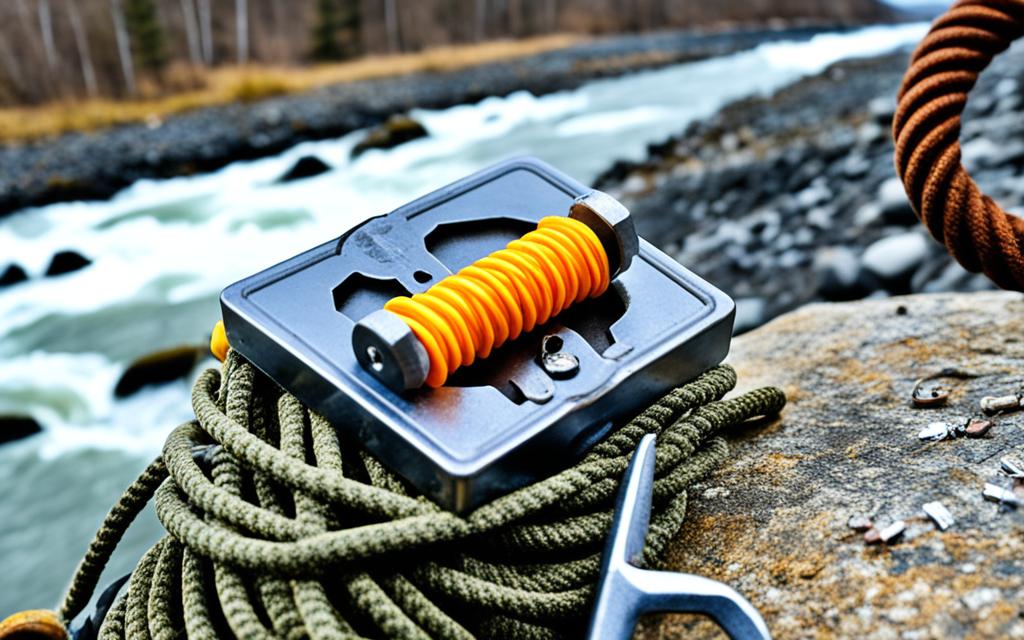Ever dreamed of going on a treasure hunt? Magnet fishing is your chance. It’s a fun hobby that mixes excitement with the calm of being by water. You use a strong neodymium magnet and rope to search rivers, lakes, and canals for lost treasures.
This hobby has become popular fast. People from all backgrounds love it for the chance to find rare treasures. You could pull up coins, jewelry, old relics, or even antique weapons. With a magnet that can lift hundreds of pounds, every cast could be a big surprise.

Magnet fishing is thrilling because you never know what you’ll catch. The excitement grows as you feel the magnet grab something under the water. It’s perfect for both experienced treasure hunters and newbies. It’s a unique way to enjoy exploring and finding hidden treasures.
Key Takeaways:
- Magnet fishing uses strong neodymium magnets to search for metal treasures in water.
- Common finds include coins, jewelry, historical relics, and antique items.
- This hobby blends the thrill of treasure hunting with the peace of being near water.
- Every cast could lead to discovering rare and valuable objects.
- It attracts both seasoned treasure hunters and curious beginners.
What is Magnet Fishing?
Magnet fishing is a fun hobby that mixes the excitement of finding treasure with the strength of neodymium magnets. It uses a strong magnet on a rope to search for metal items under water, like in lakes, rivers, and canals. This hobby has become popular, drawing in those who love adventure and history.
Unearthing Hidden Treasures from Waterways
The magic of magnet fishing is finding hidden treasures and historical items from the water. With a neodymium magnet that can pull up to 500lbs, magnet fishers can bring up many metal objects, such as:
- Antique coins and jewelry
- Vintage tools and equipment
- Wartime relics and ammunition
- Safes and lockboxes
- Bicycles and scooters
This hobby not only feeds the curiosity of those who do it but also helps preserve local history and clean up waterways.
The Thrill of Discovery and Exploration
Magnet fishing is more than just finding objects; it’s an experience that blends excitement with peace. When I throw my magnet into the water, I feel excited, not knowing what I might find. Every pull on the rope could mean a big discovery, making me love this hobby even more.
This hobby also lets me explore cities in a new way. By visiting places like old bridges, piers, and industrial sites, I find pieces of history that were forgotten. This connection to the past makes my magnet fishing trips even more meaningful.
“Magnet fishing has opened my eyes to the hidden world beneath the water’s surface. Every outing is a chance to discover something extraordinary and to piece together the stories of our past.” – A passionate magnet fisher
If you’re looking for an exciting adventure, a way to explore local waterways, or just a fun outdoor activity, magnet fishing is perfect. With a neodymium magnet and a sense of adventure, you can start an amazing journey of discovery.
Best Spots for Magnet Fishing
When it comes to magnet fishing, finding the right spot is crucial. Look for places where people and water meet, like bridges, docks, and fishing spots. These spots often have the most interesting finds.
Lakes, Ponds, and Rivers
Lakes and ponds are great for magnet fishing. They often have lost jewelry and coins. Rivers and streams can also reveal hidden treasures.
Some top rivers for magnet fishing in the U.S. include:
- The Mississippi River, with over 2,300 miles of water
- The Potomac River, offering a historical perspective ideal for uncovering relics from the Civil War era
- The Columbia River in the Pacific Northwest, with its history tied to the Lewis and Clark Expedition and pioneer days
The Great Lakes offer many chances for magnet fishing. They have a lot of maritime history and shipwrecks.
Canals, Marinas, and Docks
Canals have a mix of lost items. A drained Dutch canal once found 700,000 items, some over 500 years old. Marinas and docks are also good spots. Boaters and fishermen often lose things like fishing gear and phones.
Piers and harbors are busy places. They increase the chance of finding valuable items. You can fish from a boat or kayak, but be careful.
Historical Sites and Urban Waterways
Old bridges and ruins can have antique artifacts. But, be careful because some places have laws about magnet fishing. In South Carolina, it’s illegal in public waters.
Urban waterways, like drainage ditches, can also be good spots. Bridges are popular because many people walk over them. In London, for example, many items are lost and found here.
| Location | Potential Finds |
|---|---|
| Lakes and Ponds | Discarded jewelry, coins, metal artifacts |
| Rivers and Streams | Hidden relics, lost items |
| Canals | Mix of discarded items, historical artifacts |
| Marinas and Docks | Fishing gear, keys, phones, wallets, boating equipment, tools |
| Historical Sites | Antique artifacts, but be aware of legal concerns |
| Urban Waterways | Drainage ditches, water features |
| Bridges | Valuable items, safes, weapons |
Magnet fishermen keep their best spots secret. But, in some places, they share them with friends. Magnet fishing is popular in communities where people are open about good spots.
To find great magnet fishing spots, use Google Maps to look for where water meets roads. Bridgehunter.com is also a great tool for finding bridges to fish at.
Essential Magnet Fishing Gear
For magnet fishing, having the right gear is key. I’ve learned the importance of quality equipment over the years. Let’s explore the must-have gear for a great start.

First, get a strong neodymium fishing magnet. They range from 500 pounds to over 2,000 pounds of pull force. Beginners should start with a 660-pound magnet. Magnetar offers top-quality magnets like the 1200 Dual Series and the 2500 OMEGA Series.
Next, choose a sturdy rope for your magnet. It should be at least 6mm thick and stronger than your magnet. Magnetar’s 65 FT Double Braided Magnet Fishing Rope with a carabiner is a great pick.
I’ve used Magnetar’s rope and magnets for years. They’re durable and effective, never failing me in tough conditions.
Protect your hands with cut-resistant gloves. They’re essential for magnet fishing. These gloves keep your hands safe from sharp objects and hazards.
A grappling hook is also useful. It helps retrieve non-magnetic items or free stuck objects. Choose a hook that’s light but strong for magnet fishing.
| Gear | Recommended Product | Price |
|---|---|---|
| Fishing Magnet | 2500 OMEGA Series – 360° Fishing Magnet | $159.99 (on sale) |
| Rope | 65 FT Double Braided Magnet Fishing Rope 8mm with Carabiner | $29.99 (on sale) |
| Gloves | Cut-Resistant Gloves | Varies |
| Grappling Hook | Lightweight, Sturdy Grappling Hook | Varies |
For advanced magnet fishing, consider a complete kit. Kratos Magnetics and Magnetar offer various kits for different budgets and skills.
- Family Kit (Kratos Magnetics): $59
- Deluxe Kit (Kratos Magnetics): $143
- Pro Magnet Fishing Kit | 950 Alpha Series (Magnetar): $94.99 (on sale)
- Pro Magnet Fishing Kit | 1400 Alpha Series (Magnetar): $119.99 (on sale)
- Pro Magnet Fishing Kit | 2400 Alpha Series (Magnetar): $169.99 (on sale)
With the right gear, you’re set for magnet fishing fun. Always focus on safety and respect the environment in your treasure hunts.
Magnet Fishing Adventures: Real-Life Stories
Magnet fishing can lead to amazing discoveries, like historical artifacts and valuable treasures. I’ve gone on exciting expeditions, finding fascinating things in places you wouldn’t expect. Exploring a local lake or an old well, the thrill is in not knowing what’s hidden below.
Relic Hunting in a Local Lake
One of my top memories was at a local lake with a deep history. I used my magnet fishing kit to search for relics. After a few hours, I found antique tools that a boat mechanic must have lost.
These tools showed me the lake’s history and the people who worked there before.
Treasure Hunting at the Bottom of an Old Well
Another great experience was at an old well from the 1800s. I focused on the smaller well and felt a strong pull with my magnet. I pulled out a bunch of antique items, like coins and a pocket watch.
These finds showed me the surprise treasures you can find in unexpected places.
Magnet fishing adventures like these make me love this hobby even more. The thrill of finding history and treasures keeps me going. Whether it’s in a lake or an old well, magnet fishing always excites me. With every cast, I look forward to the next big find, ready for more adventures.
FAQ
What is the best type of magnet for magnet fishing?
The top magnets for magnet fishing are strong neodymium magnets. The MMS-G-Y8 and MMS-A-Y8 magnets from K&J Magnetics are great choices. They have a strong magnetic field and come with an eye-hook or a countersunk hole for attaching a rope.
What are some of the best locations for magnet fishing?
Great spots for magnet fishing include lakes, ponds, and fast rivers. Man-made canals, marinas, and docks are also good places. Don’t forget areas beneath bridges, urban waterways, and historical sites with old bridges or piers.
Public parks with water, coastal beaches, and popular fishing spots are also worth trying.
What kind of treasures can I find while magnet fishing?
Magnet fishing can uncover everything from metal scraps to historical artifacts. You might find coins, jewelry, antique relics, fishing gear, and lost tools.
What equipment do I need to start magnet fishing?
You’ll need a strong neodymium magnet and a sturdy rope for magnet fishing. Make sure the rope can handle the magnet’s weight and any finds. Wear protective gloves to prevent injuries.
Adding a grappling hook can help with retrieving non-magnetic items or freeing stuck finds.
Is magnet fishing legal?
Magnet fishing laws vary by location. Always check local laws and regulations before you start. Some areas may have restrictions or require permits.
Always get permission from landowners if you’re fishing on private property.
What should I do if I find a potentially dangerous or historically significant item?
If you find something dangerous like a weapon or an explosive, don’t touch it. Call the authorities right away.
If it looks like a historical item, report it to local heritage groups or museums. They can handle it properly.